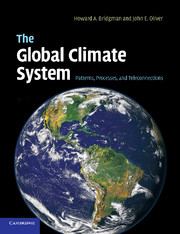Book contents
- Frontmatter
- Contents
- List of contributors
- Preface
- List of abbreviations
- 1 Introduction
- 2 Oscillations and teleconnections
- 3 Tropical climates
- 4 Middle-latitude climates
- 5 Climate of the polar realms
- 6 Post-glacial climatic change and variability
- 7 Urban impacts on climate
- 8 Human response to climate change
- 9 ESSAY: Model interpretation of climate signals: an application to Asian monsoon climate (Lau)
- 10 Conclusions and the future of climate research
- Other books on climatology and the climate system
- Index
- Plate section
- References
10 - Conclusions and the future of climate research
Published online by Cambridge University Press: 05 June 2012
- Frontmatter
- Contents
- List of contributors
- Preface
- List of abbreviations
- 1 Introduction
- 2 Oscillations and teleconnections
- 3 Tropical climates
- 4 Middle-latitude climates
- 5 Climate of the polar realms
- 6 Post-glacial climatic change and variability
- 7 Urban impacts on climate
- 8 Human response to climate change
- 9 ESSAY: Model interpretation of climate signals: an application to Asian monsoon climate (Lau)
- 10 Conclusions and the future of climate research
- Other books on climatology and the climate system
- Index
- Plate section
- References
Summary
Introduction
We have emphasized in this book the importance of considering climate, climate change, and climate variability in terms of interacting components of a system, with many different, often simultaneous, impacts. This chapter describes some of the important research areas for the future which should lead to better understanding of the climate system.
The climate system can be considered complex, highly non-linear, and chaotic, with variations consisting broadly of two types. The first is longer-term transition changes, such as some of those described in Chapter 6, relating to forces such as polar wandering, changes in the Earth's tilt, changes in the Earth's orbit around the Sun, and the ice ages. The second is short-term abrupt changes, relating to rapid variations in forcing functions, such as the radiative output from the Sun and particulate matter from volcanic eruptions. The most recent short-term forcing function is human activity and its impact on the atmosphere.
Programs and organizations
Over the past three decades, there have been major advances in understanding how the climate system operates. These include improvements in forecasting, understanding of the role of sea ice, interactions between the atmosphere and ocean, the role of atmospheric chemistry, and so forth. The more we learn, the more we seem to need to know. Over the past 20 years, the study of the climate system has moved strongly onto the international stage. Table 10.1 presents a summary of major organizations and projects that cover a wide range of climate and related research.
- Type
- Chapter
- Information
- The Global Climate SystemPatterns, Processes, and Teleconnections, pp. 309 - 320Publisher: Cambridge University PressPrint publication year: 2006

